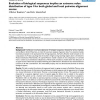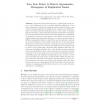8 search results - page 1 / 2 » Simulating Evolution with a Computational Model of Embryogen... |
ECAL
2005
Springer
13 years 10 months ago
2005
Springer
Abstract. An evolutionary system is presented which employs an embryogeny model to evolve phenotypes in the form of layout of cells in specific patterns and shapes. It is shown th...
AICOM
2002
13 years 4 months ago
2002
The computational potential of artificial living systems can be studied without knowing the algorithms that govern their behavior. Modeling single organisms by means of socalled c...
WWW
2008
ACM
14 years 5 months ago
2008
ACM
We discover communities from social network data, and analyze the community evolution. These communities are inherent characteristics of human interaction in online social network...
BMCBI
2008
13 years 4 months ago
2008
Background: Confidence in pairwise alignments of biological sequences, obtained by various methods such as Blast or Smith-Waterman, is critical for automatic analyses of genomic d...
RECOMB
2005
Springer
14 years 5 months ago
2005
Springer
Abstract. Asymmetric functional divergence of paralogues is a key aspect of the traditional model of evolution following duplication. If one gene continues to perform the ancestral...


